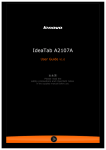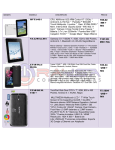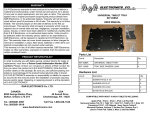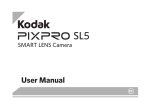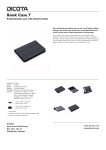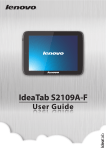Download Lenovo A2107A User's Manual
Transcript
Lenovo IdeaTab A2107A ©Lenovo China 2012 New World. New Thinking.TM 60015/2298 User Guide V1.0 www.lenovo.com Read the safety notic es and important tips in the included manuals before using your computer. V1.0_en-US Notes • Before using the product, be sure to read Important safety and handling information first. • Some instructions in this guide may assume that you are using Android. If you are using other Windows operating system, some operations may be slightly different. If you are using other operating systems, some operations may not apply to you. • The features described in this guide are common to most models. Some features may not be available on your computer and/or your computer may include features that are not described in this user guide. • The illustrations in this manual may differ from the product you are using. Regulatory Notice • To refer to it, go to http://support.lenovo.com and click User guides and manuals. First Edition (August 2012) © Copyright Lenovo 2012. LIMITED AND RESTRICTED RIGHTS NOTICE: If data or software is delivered pursuant a General Services Administration “GSA” contract, use, reproduction, or disclosure is subject to restrictions set forth in Contract No. GS-35F-05925. Contents Chapter 1. Getting to know your computer .......................................... 1 Front view ....................................................................................................................1 Right-side view............................................................................................................2 Top view .......................................................................................................................2 Rear view......................................................................................................................3 Chapter 2. Learning the basics.............................................................. 4 First use.........................................................................................................................4 Using AC adapter and battery ..................................................................................7 Connecting external devices......................................................................................7 Chapter 3. Connecting to the Internet................................................... 8 Wireless connection ....................................................................................................8 Specifications.......................................................................................... 9 FCC Compliance Statement................................................................. 11 Appendix................................................................................................ 13 i Chapter 1. Getting to know your computer Front view ----------------------------------------------------------------------------------------------1 2 a Integrated camera Use the camera for video communication. b Multi-touch screen Functions as both the primary output and the primary input component. 1 Chapter 1. Getting to know your computer Right-side view ---------------------------------------------------------------------------------- 1 a Volume up/down Adjusts system sound. Top view --------------------------------------------------------------------------------------------------- 1 2 3 4 a Built-in microphone Captures sound and can be used for video conferencing, voice narration, or audio recording. b Composite audio jack Accommodates headsets or headphones. This jack does not support conventional microphones. Attention: • Listening to music at high volume over extended periods of time may damage your hearing. • c Micro USB port d Power button 2 Powers on the tablet. Chapter 1. Getting to know your computer Rear view -----------------------------------------------------------------------------------------------1 2 3 a Integrated camera Use the camera for video communication. b WLAN/Bluetooth antennas Connected to the WLAN/Bluetooth adapter and are used for sending and receiving wireless signals. c Speaker Provides audio output. 3 Chapter 2. Learning the basics First use ------------------------------------------------------------------------------------------------------ Reading the manuals Read the supplied manuals before using your computer. Turning on the computer Press the power button to turn on the computer. Configuring the operating system You may need to configure the operating system when it is first used. The configuration process may include the procedures below. • Accepting the end user license agreement • Configuring the Internet connection • Registering the operating system • Creating a user account User safety information • Please carefully read the user manual before use. • Please do not switch on the tablet when using the tablet is prohibited or using the tablet could lead to interference or hazards. • Please keep the tablet switched off on airplanes. If the tablet is equipped with functionality which automatically activates the device such as an alarm clock or calendar function, please check and remove this before boarding. • When using the tablet, keep away from hot or high-voltage environments, such as electronic appliances or cooking equipment. • Prevent fires. Please switch off the tablet in areas containing flammable objects such as petrol stations and fuel stores. • Using a tablet case or plastic case could cause damage to the tablet’s exterior paint. • The use of solvents such as benzene, diluents or alcohol to wipe the exterior casing of the tablet is strictly forbidden. Bringing your tablet into contact with corrosive chemicals such as detergents is strictly forbidden. Only clean, soft cloth may be used to gently wipe the tablet. 4 Chapter 2. Learning the basics • Leaving the tablet under the sun, or placing it in a smoky or dusty environment is strictly forbidden. • Your tablet is not water proof; please keep it dry. Use in humid areas such as bathrooms is strictly forbidden. Causing the tablet to be exposed to rain or moistness is strictly forbidden. Do not attempt to replace the internal battery Replacement of the internal rechargeable battery or internal coin-cell battery must be done by a Lenovo-authorized repair facility. The Lenovo-authorized repair facilities recycle Lenovo batteries according to local laws and regulations. The following statement applies to users in the state of California, U.S.A.: Products containing CR (manganese dioxide) lithium coin cell batteries may contain perchlorate. Perchlorate Material - special handling may apply. Go to: http://www.dtsc.ca.gov/hazardouswaste/perchlorate. Because the internal lithium coin cell battery is not an end-user accessible part, no special handling is required by the end user other than disposing of the tablet in a manner consistent with local law when the tablet is at the end of its useful life. Use approved charging methods only Please only use the power adapter provided with your tablet for charging the battery. When using chargers, please abide by the following. • Before use, please carefully read the user manual and labels on the charger. • Please do not disassemble or refit the charger, using the charger when the cable is damaged is strictly prohibited, otherwise this could cause electrocution, fire or charger damage. • Touching the charger with wet hands is strictly prohibited. If the charger comes into contact with water or other liquids, cut the power immediately. • Short circuiting the charger is strictly prohibited; mechanically vibrating or shaking the device is strictly forbidden; exposure to direct sunlight is directly prohibited; using the charger in humid locations such as bathrooms is strictly forbidden. This device is not water-resistance, it is strictly forbidden to expose the device to rain or moisture. • Please do not use the charger near devices such as televisions or radios. 5 Chapter 2. Learning the basics • When unplugging, hold the charger firmly; pulling the cord could damage it. • To prevent hazards, please place the charger in a safe location out of reach of children. Charging devices might become warm during normal use. Allow for adequate ventilation around the charging device. Unplug the charging device if any of the following occur: • The power cord for the charging device is frayed or damaged. • The charging device has been exposed to rain, liquid, or excessive moisture. • The charging device shows signs of physical damage. • You want to clean the charging device. Lenovo is not responsible for the performance or safety of products not manufactured or approved by Lenovo. Prevent hearing damage Caution: Excessive sound pressure from earphones and headphones can cause hearing loss. Adjustment of the equalizer to maximum increases the earphones and headphones output voltage and therefore the sound pressure level. 6 Chapter 2. Learning the basics Using AC adapter and battery --------------------------------------------------------- Checking battery status You can determine the percentage of battery power remaining by checking the battery icon in the notification area. Charging the battery When you find that the battery power is low, you need to charge the battery or replace it with a fully charged one. You need to charge the battery in any of the following situations: • If the battery status indicator starts blinking • If the battery has not been used for a long time Notes: • To increase the life of the battery pack, the computer does not start recharging the battery immediately after it drops from fully charged. • Charge the battery at a temperature between 50 °F and 86 °F (10 °C-30 °C). • Full charge or discharge is not required. Connecting external devices -----------------------------------------------------------Your computer has a wide range of built-in features and connection capabilities. Connecting Bluetooth enabled devices (on select models) If your computer has an integrated Bluetooth adapter card, it can connect to and transfer data wirelessly with other Bluetooth enabled devices, such as notebook computers, PDAs and cell phones. You can transfer data between these devices without cables and up to 10 meters range in open space. Note: The actual maximum range may vary due to interference and transmission barriers. To get the best possible connection speed, place the device as near your computer as possible. 7 Chapter 3. Connecting to the Internet As a global network, the Internet connects computers worldwide, providing services such as e-mailing, information searching, electronic commerce, Web browsing and entertainment. You can connect the computer to the Internet in the following ways: Wireless network technology: connect without wiring. Wireless connection ---------------------------------------------------------------------------Wireless connections provide mobile access to the Internet, allowing you to stay online anywhere the wireless signal covers. Divided by the signal scales, wireless connection to the Internet can be built based on the following standards. Wi-Fi Wi-Fi networks cover a small physical area, like a home, office, or small group of buildings. An access point is necessary for the connection. Note: Your computer may not support all wireless connection methods. Using Wi-Fi (on select models) Hardware connection Wi-Fi network Access point * * Not supplied 8 Specifications Model Name: Lenovo IdeaTab A2107A Machine Type: 60015, 2298 Note: The following specifications may contain technical inaccuracies or typographical errors. Lenovo reserves the right to improve and/or change specifications at any time without notice. Form Factor Dimensions Weight LCD size Appr. 192mm × 121.8mm × 11.5mm Appr. 400 g 7.0” (1,024 × 600 Widescreen view) Platform Platform MTK 6575 1GHz Memory Type and speed Maximum supported capacity DDR3L 1 GB eMMC Capacity 8 GB / 16 GB Display Display resolution (LCD) LCD backlight 1,024 × 600 pixels LED I/O Ports USB Micro USB port × 1 Audio Combo audio jack × 1 Communication WLAN (802.11 b/g/n) Bluetooth 3.0 9 Specifications Battery pack Cells/Capacity 1-cell Li-polymer battery AC adapter AC adapter 5 V / 1.5 A AC Miscellaneous Camera 10 0.3M on front/2.0M on back FCC Compliance Statement Federal Communications Commission Declaration of Conformity Lenovo Tablet PC and Model: 60015; 2298 This equipment has been tested and found to comply with the limits for a Class B digital device, pursuant to Part 15 of the FCC Rules. These limits are designed to provide reasonable protection against harmful interference in a residential installation. This equipment generates, uses, and can radiate radio frequency energy and, if not installed and used in accordance with the instructions, may cause harmful interference to radio communications. However, there is no guarantee that interference will not occur in a particular installation. If this equipment does cause harmful interference to radio or television reception, which can be determined by turning the equipment off and on, the user is encouraged to try to correct the interference by one or more of the following measures: - Reorient or relocate the receiving antenna. - Increase the separation between the equipment and receiver. - Connect the equipment into an outlet on a circuit different from that to which the receiver is connected. - Consult an authorized dealer or service representative for help. Lenovo is not responsible for any radio or television interference caused by using other than recommended cables and connectors or by unauthorized changes or modifications to this equipment. Unauthorized changes or modifications could void the user’s authority to operate the equipment. This device complies with Part 15 of the FCC Rules. Operation is subject to the following two conditions: (1) this device may not cause harmful interference, and (2) this device must accept any interference received, including interference that may cause undesired operation. Responsible Party: Lenovo (United States) Incorporated 1009 Think Place-Building One Morrisville, NC 27560 Telephone: 1-919-294-5900 11 FCC Compliance Statement FCC Caution: Any Changes or modifications not expressly approved by the party responsible for compliance could void the user's authority to operate the equipment. The antenna(s) used for this transmitter must not be co-located or operating in conjunction with any other antenna or transmitter. Note: The country code selection is for non-US model only and is not available to all US model. Per FCC regulation, all WiFi product marketed in US must fixed to US operation channels only. RF Exposure Information (SAR) The exposure standard for wireless device employs a unit of measurement known as the Specific Absorption Rate, or SAR. The SAR limit set by the FCC is 1.6W/kg. *Tests for SAR are conducted using standard operating positions accepted by the FCC with the device transmitting at its highest certified power level in all tested frequency bands. Although the SAR is determined at the highest certified power level, the actual SAR level of the device while operating can be well below the maximum value. This is because the device is designed to operate at multiple power levels so as to use only the poser required to reach the network. In general, the closer you are to a wireless base station antenna, the lower the power output. The highest SAR value for the device as reported to the FCC when tested for worn on the body, as described in this user guide, is 1.34 W/kg (Body- worn measurements differ among device models, depending upon available accessories and FCC requirements.) While there may be differences between the SAR levels of various devices and at various positions, they all meet the government requirement. The FCC has granted an Equipment Authorization for this model device with all reported SAR levels evaluated as in compliance with the FCC RF exposure guidelines. SAR information on this model device is on file with the FCC and can be found under the Display Grant section of www.fcc.gov/oet/ea/fccid after searching on FCC ID: O57A2107AF. 12 European Community Compliance Statement This equipment is marked with the 0700 symbol and can be used throughout the European community. This device complies with the essential requirements of the R&TTE Directive 1999/5/EC. The following test methods have been applied in order to prove presumption of conformity with the essential requirements of the R&TTE Directive 1999/5/EC: EN 300 328 V1.7.1: 2006 - Electromagnetic compatibility and Radio spectrum Matters (ERM); Wideband Transmission Systems; Data transmission equipment operating in the 2,4GHz ISM band and using spread spectrum modulation techniques; Harmonized EN covering essential requirements under article 3.2 of the R&TTE directive. EN 300 440-1 V1.6.1: 2010 - Electromagnetic compatibility and Radio spectrum Matters (ERM); Short range devices; Radio equipment to be used in the 1 GHz to 40 GHz frequency range; Part 1: Technical characteristics and test methods. EN 300 440-2 V1.4.1:2010 - Electromagnetic compatibility and Radio spectrum Matters (ERM); Short range devices; Radio equipment to be used in the 1 GHz to 40 GHz frequency range; Part 2: Harmonized EN covering the essential requirements of article 3.2 of the R&TTE Directive. EN 301 489-1 V1.8.1: 2008-04 - Electromagnetic compatibility and Radio spectrum Matters (ERM), Electromagnetic Compatibility (EMC) standard for radio equipment and services; Part 1: Common technical requirements. EN 301 489-3 V1.4.1: 2002-08 - Electromagnetic compatibility and Radio spectrum Matters (ERM); ElectroMagnetic Compatibility (EMC) standard for radio equipment and services; Part 3: Specific conditions for Short-Range Devices (SRD) operating on frequencies between 9 kHz and 40 GHz. 13 European Community Compliance Statement EN 301 489-17 V2.1.1: 2009-05 - Electromagnetic Compatibility and Radio Spectrum Matters (ERM); Electromagnetic Compatibility (EMC) standard for radio equipment and services; Part 17 Specific Conditions for 2.4GHZ Wideband Data and 5GHz high performance RLAN Equipment. EN 60950-1:2006+A11:2009:+A1:2010+A12:2011 - Safety of Information Technology Equipment.-Safety-Part 1: General requirements. EN 50332-2:2003 - Sound system equipment: Headphones and earphones associated with portable audio equipment - Maximum sound pressure level measurement methodology and limit considerations - Part 2: Matching of sets with headphones if either or both are offered separately. EN 62311:2008 - Assessment of electronic and electrical equipment related to human exposure restrictions for electromagnetic fields (0 Hz - 300 GHz). EN 62209-2:2010 - Human exposure to radio frequency fields from handheld and bodymounted wireless communication devices - Human models, instrumentation, and procedures Part 2: Procedure to determine the specific absorption rate (SAR) for wireless communication devices used in close proximity to the human body (frequency range of 30 MHz to 6 GHz) (IEC62209-2:2010) EN 62479:2010 - Assessment of the compliance of low power electronic and electrical equipment with the basic restrictions related to human exposure to electromagnetic fields (10 MHz to 300 GHz) 14 European Community Compliance Statement Marking by the symbol indicates that usage restrictions apply. This device is a 2.4 GHz wideband transmission system (transceiver), intended for use in all EU member states and EFTA countries, except in France and Italy where restrictive use applies. In Italy the end-user should apply for a license at the national spectrum authorities in order to obtain authorization to use the device for setting up outdoor radio links and/or for supplying public access to telecommunications and/or network services. This device may not be used for setting up outdoor radio links in France and in some areas the RF output power may be limited to 10 mW EIRP in the frequency range of 2454 - 2483.5 MHz. For detailed information the end-user should contact the national spectrum authority in France. For the device which tests accordance to EN 60950-1: 2006+A11:2009:+A1:2010+A12:2011, it is mandatory to perform audio tests for EN50332. This device have been tested to comply with the Sound Pressure Level requirement laid down in the applicable EN 50332-1and/or EN 50332-2 standards. Permanent hearing loss may occur if earphones or headphones are used at high volume for prolonged periods of time. Warning statement: A pleine puissance, l'écoute prolongée du baladeur peut endommager l'oreille de l'utilisateur. 15 European Community Compliance Statement CE SAR Information THIS MOBILE DEVICE MEETS GUIDELINES FOR EXPOSURE TO RADIO WAVES. Your mobile device is a radio transmitter and receiver. It is designed not to exceed the limits for exposure to radio waves recommended by international guidelines. These guidelines were developed by the independent scientific organization ICNIRP and include safety margins designed to assure the protection of all persons, regardless of age and health. The exposure guidelines for mobile devices employ a unit of measurement known as the Specific Absorption Rate or SAR. The SAR limit stated in the ICNIRP guidelines is 2.0 W/kg averaged over 10 grams of tissue. Tests for SAR are conducted using standard operating positions with the device transmitting at its highest certified power level in all tested frequency bands. The actual SAR level of an operating device can be below the maximum value because the device is designed to use only the power required to reach the network. That amount changes depending on a number of factors such as how close you are to a network base station. The highest SAR value under the ICNIRP guidelines for use of the device at the body is 0.369 W/kg. Use of device accessories and enhancements may result in different SAR values. SAR values may vary depending on national reporting and testing requirements and the network band. The device could be used with a separation distance of 0 cm to the human body. 16 Appendix WEEE Notice Recycling and environmental information Lenovo encourages owners of information technology (IT) equipment to responsibly recycle their equipment when it is no longer needed. Lenovo offers a variety of programs and services to assist equipment owners in recycling their IT products. For information on recycling Lenovo products, go to: http://www.lenovo.com/recycling Important WEEE information Country-specific information is available at: http://www.lenovo.com/recycling Restriction of Hazardous Substances Directive (RoHS) The Lenovo product meets the requirements of the EU Directive (2011/65/ EU) on the Restriction of the Use of Certain Hazardous Substances in Electrical and Electronic Equipment (EEE). 17 Notes • Before using the product, be sure to read Important safety and handling information first. • Some instructions in this guide may assume that you are using Android. If you are using other Windows operating system, some operations may be slightly different. If you are using other operating systems, some operations may not apply to you. • The features described in this guide are common to most models. Some features may not be available on your computer and/or your computer may include features that are not described in this user guide. • The illustrations in this manual may differ from the product you are using. Regulatory Notice • To refer to it, go to http://support.lenovo.com and click User guides and manuals. First Edition (August 2012) © Copyright Lenovo 2012. LIMITED AND RESTRICTED RIGHTS NOTICE: If data or software is delivered pursuant a General Services Administration “GSA” contract, use, reproduction, or disclosure is subject to restrictions set forth in Contract No. GS-35F-05925. Lenovo IdeaTab A2107A ©Lenovo China 2012 New World. New Thinking.TM 60015/2298 User Guide V1.0 www.lenovo.com Read the safety notic es and important tips in the included manuals before using your computer. V1.0_en-US























